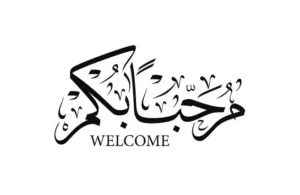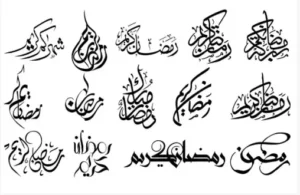Arabic calligraphy is hotly contested whether writing in the ancient languages of Aramaic, Nabatean, or Syriac is where the Arabic text originated. The earliest known use of writing dates back to the sixth century. It was mostly recorded on papyrus in Egypt. It is best to think of it as a visually stunning art form that embodies the beauty of the Arabic language and culture.
History of Arabic Calligraphy

The genuine art of Arabic calligraphy began to take shape in the 7th century when a profound commitment to the words of the Quran resulted in an exquisite transcription. Given the widespread perception that Islam is the most authentic and pure religion.
Calligraphy was used to preserve the Quran in writing form once Islam spread. The term “Islamic Calligraphy” is therefore thought by experts to be more fitting than ” Calligraphy,” given its long history of religious growth in Persia, Turkey, and other non-Arabic-speaking nations.
Originally, the document was intended to spread concepts and philosophies throughout the Arab world and the vast Islamic civilizations. Coins, engravings, and graffiti from the Arab world make up a sizable portion of what has been preserved. However, the script was not widely employed because telling stories orally is a traditional tradition.
Popular Calligraphy Styles

Islamic calligraphy can be divided into six primary styles, excluding minor variants. The earliest known form of Arabic writing is the Kufic style, but tt was discovered in pre-Islamic Arabic script from Iraq dating back to 512 A.D. Kufic is primarily found in building and architectural etchings.
The dots (Nuqta/نقطة) that we use to distinguish different letters in Arabic writing today were not even used in the earliest Arabic writing. Based on the word’s placement and the sentence’s context, the letter was inferred rather than written.
Afterward, the dots were added to make it easier for readers to comprehend and pronounce the words. Different Kufic iterations evolved into their style.
Neskh is another prominent style that dates back to the tenth century. This script was a more standardized variant of the one used in government papers. For instance, in the writing of the Quran and communications between monarchs and governors. Neskh ornamentation was used for metalwork and pottery.
Basic Techniques
Arabic calligraphy or styled handwriting that incorporates words and phrases from the Quran is known as Islamic calligraphy art. This form of artistic expression first appeared after the Prophet Muhammad used the Quran, which is the entire word and message of God, to propagate Islam.
Arabic calligraphy was improved to become known as Islamic calligraphy to provide aesthetic appeal to copies of the Quranic text, structures, artifacts, and houses of worship.
The words and phrases inspired by the Quran are utilized for artistic and beautifying purposes in the Islamic world, emitting beauty, reverence, and intentional beauty, as images and idols are forbidden in the Islamic faith for creative expression or decorative purposes.
Examples of Calligraphy Art
Arabic calligraphy adheres to the fundamental principles of Arabic script, which are to write characters linearly, curvedly, and with dots denoting both vowel and consonant sounds and letters. Certain characters are connected to neighboring characters, whereas others are connected to the letter that comes before or after them only.
Depending on where they fall in a word—at the start, middle, or finish—some letters assume distinct shapes. The elaborate Islamic calligraphy style strikes a balance between the usage of inked letters and characters. And available space when forming characters into words and phrases.
Arabic calligraphy comes in a variety of styles that represent the various eras and influences that have shaped its development and use. Islamic calligraphy’s primary forms include:
Kufic, Arabic Calligraphy
The Prophet Muhammad wrote in the original Arabic script. stiff and linear style.
Naskh: The cursive style that eventually became the norm for reproducing the Quran and other texts.
Maghribi: Another name for western style. used in North Africa by Muslim communities.
The Arabic script’s earliest variant is called Kufic. The original Kufic style was extremely rigid and straight, lacking any accents or dots. Diacritical markings were used in the 7th century which aids readers in pronouncing the Quran and other significant texts.
Coins and stone carvings could easily be made in the straight style. This style was used in the 8th-10th centuries in the Quran. The Quran was copied using this method between the eighth and tenth centuries. You can learn this with e Arabic learning.
Conclusion
Arabic calligraphy is a fascinating art form with a fascinating past. Even now, people practice this delicate and intricate art form. It requires years and a great deal of work to master.
Experts know how important it is to provide their pupils with exact corrections and work on honing their skills so that the art can be respectfully passed down. Islamic calligraphy still inspires people worldwide by beautifully capturing the beauty of the Arabic language.
